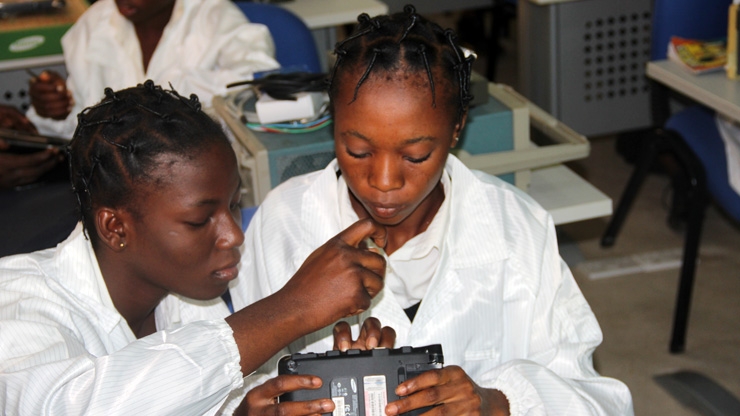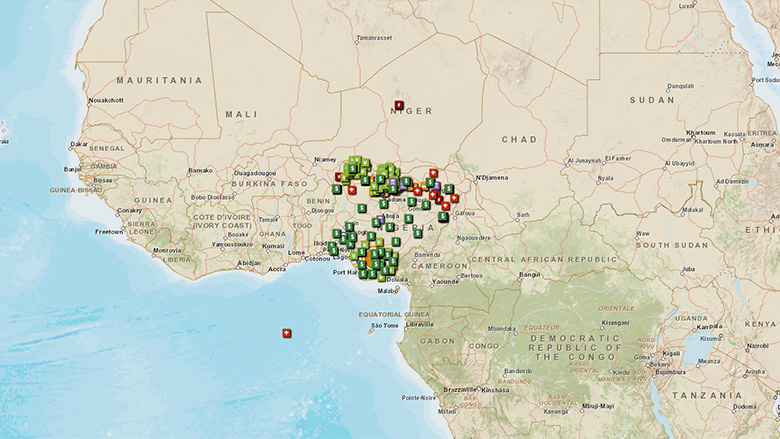Challenge
Despite Nigeria’s strong economic track record, poverty is significant, and reducing it will require strong non-oil growth and a focus on human development. Constraints have been identified to enhancing growth, including the investment climate; infrastructure, incentives and policies affecting agricultural productivity; and quality and relevance of tertiary education. In spite of successful initiatives in human development, Nigeria may not be on track for meeting most of the Millennium Development Goals (MDGs) (more will be known after the analysis of the recently completed NLSS). Underpinning these challenges is the core issue of governance, in particular at the state level. Fiscal decentralization provides Nigeria’s 36 states and 774 local governments considerable policy autonomy, control of 50% of government revenues, and responsibility for delivery of public services. Capacity is weak in most states, and improving governance will be a long term process.
Solution
The FY2010-2013 Country Partnership Strategy focuses on three themes to transform and diversify Nigeria’s economy; improving governance, maintaining non-oil growth and promoting human development.
Governance support covers five areas: transparency and accountability; participation; sector governance; capacity development; judicial reform and democratic governance. All partners take part in strengthening government systems to improve outcomes in human development and growth; but only the Department for International Development (DFID) and USAID focus on judicial reform and democratic processes.
Results
- The HIV/AIDS Program Development Project I project: In addition to strengthening the Nigerian government’s capacity to plan and implement HIV/AIDS programs, the project also focuses on behavior change and access to counseling, testing and care services to reduce the transmission of the infection and its impact. The project has contributed to the reduction in the national HIV prevalence of 5.2% in 2003 to 4.6% in 2008 and an increase in the percentage of women (15-49) reporting the use of condom the last time they had sex with a non-marital, non-cohabiting sexual partner from 6.5% in 2002 to 33.4% in 2008.
- Malaria Control Booster Project: The percentage of households with at least one insecticide treated bed net (ITN)/long lasting insecticide treated nets increased from 2.4% in 2006 to 89.7% in 2010 in the seven project states covered under the Malaria project.
The percentage of children under five-years-old with fever treated with an effective anti-malarial medicine within 24 hours from onset of systems increased from 3.7% in 2006 to 6.9% in 2010 and the percentage of children less than five-years-old that slept under an insecticide treated bed nets increased from 3.6% in 2006 to 41.8% in 2010. The increase in coverage stem from the 12.4 million bed nets and 7.5 million doses of malaria medicine procured and distributed through project funds. In addition the project support the strengthening of health systems in the seven project states particularly procurement and supply chain management, monitoring and evaluation, and communications. - Second National Fadama Development Project: Fadama II project contributed to agricultural growth. The productive assets component enabled the beneficiaries to acquire 75,599 pieces of equipment through 7,766 subprojects involving 3.4 million beneficiaries. By the end of project, average increase in real income of project beneficiaries was 63%.
At project completion, in 2009, the real income of 50% of beneficiaries of the Second National Fadama Development Project is estimated to have increased by 63%. An independent evaluation of the project conducted at mid-term by the International Food Policy Research Institute (IFPRI) portrayed this trend.
By the end of the project, 60% of Fadama Community Associations (FCAs) have successfully implemented their Local Development Plans (LDPs) and other project-funded activities using environmentally sustainable and socially inclusive practices.
Approximately 84% of the FCAs had satisfactorily Implemented their LDPs. The project established 1,470 FCAs and successfully implemented 1,246 LDPs out of the 1,318 submitted. This result shows that about 95% of the LDPs demanded by the beneficiaries have been implemented. In addition, more than 90% of the productive assets micro-projects/subprojects demanded by the Fadama User Groups (FUGs) have been completed. The support provided under the productive assets component enabled the beneficiaries to acquire 73,599 pieces of equipment through 7,766 subprojects. The total number of FUGs involved in these subprojects came to 6,301, involving approximately 3.4 million households. Subprojects funded under this project were subjected to rigorous screening to test for environmental sustainability and were prepared in a socially-inclusive and participatory manner, using the LDP tool and the Community-Driven Development (CDD) approach.
By year six, conflicts between Fadama users have been reduced by 75 percent. By December 2009, six of the participating states registered no conflicts, while the remaining six states reported only a few isolated cases of minor conflicts, reflecting a reduction of 85% compared to the baseline. This notable achievement is attributable to the successful adoption of the LDP, as a planning tool which brings all the participating economic interest/resource-user groups (sedentary farmers, pastoralists, gatherers, etc.) to the table, and participate in a socially inclusive process of collectively identifying the development priorities of their respective communities and translating those priorities into investment activities, which are written into their (FCA) LDP and the associated budget. Any investment subproject that is not reflected in the approved LDP is not eligible for financing by the project. Approval of an LDP is subject, among other things, to passing a test indicating that the integrity of the LDP process, especially in terms of social inclusion and participation, has been respected. Moreover, the Second National Fadama Development Project included specific interventions under the Infrastructure component to finance cross-FCA infrastructure, including stock routes, grazing reserves and watering points. Neglect of the economic interests of pastoralists under Fadama I was the main cause of the reported farmer-pastoralist conflicts which led the Second National Fadama Development Project to be classified as a Corporate Risk project, upstream. - Lagos Urban Transport project: The project closed in 2008 and was rated highly satisfactory. As a result of the project, there has been:
1. A reduction of time and money spent by poor households for travel
- Time spent by poor households on travel along project corridors
- Money spent by poor households as a share of income along project corridor.
2. A reduction of accidents
3. Number of person-days of labor created Same
4. Additional Indicator Length of bus-km franchise per day
Bank Group Contribution
The World Bank is helping to fight poverty and improve living standards for the people of Nigeria. As of March, 2013, the World Bank had approved over 130 International Bank for Reconstruction and Development (IBRD) loans and International Development Association (IDA) credits to Nigeria. The commitment value is US$4.9 billion in 24 national and three regional IDA projects.
Partners
The FY2010-2013 CPS includes the African Development Bank (AfDB), USAID, DFID, and the World Bank Group. The partners account for over 80% of Nigeria’s development assistance. By agreeing to a single joint strategy, partners will strengthen the likelihood of development effectiveness.
Partners will continue to work closely with Nigeria’s other main development partners, including United Nations funds, programs and agencies, Japanese International Cooperation Agency, the French Agency for International Development, Canadian International Development Agency, and the European Commission. Some of these partners expect to join the partnership during the CPS period.
DFID will focus on infrastructure and policy advice, investment climate and business enterprise programs, health systems, immunization, girls’ education, and strengthening of National Assembly.
USAID priorities are state-level fiscal policy and public procurement reform, human resource development, agriculture value chain development, food security, trade reform, energy, and climate change investments.
AfDB will target energy, transportation, water supply and health systems. In many areas, partners will work jointly: DFID, USAID and the Bank in investment climate, enterprise development, health systems, HIV/AIDS, girls’ education in Northern Nigeria; and with AfDB in energy and transportation. Further integration of trust fund activities will be expanded over the CPS period.
Moving Forward
To achieve better governance, the CPS determines how the Bank can help the government strengthen its own systems over the long term (beyond fiduciary control over IDA funds given that the Bank is a small player in Nigeria). Governance is both a core theme and a cross-cutting theme, that is, an integral part of virtually every form of support. Each partner focuses on these three areas, with varying degrees of emphasis. The partnership also provides support to the government to deal with the global crisis.
Key Words
Education, Institutional Strengthening, Women Empowerment, Primary Health, HIV/AIDS, Institutional Strengthening, Maternal Health, Agriculture, Transport, Statistics, Water & Sanitation.
Beneficiary:
“As a fisherman, there has been a lot of improvement in my life since I joined the Fadama User Group. I had only one boat before now, but today, I have four. Also, I engaged two men working for me, but since I joined Fadama, I have since increased it to eight” - Raufu Alaka.


